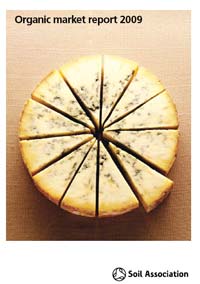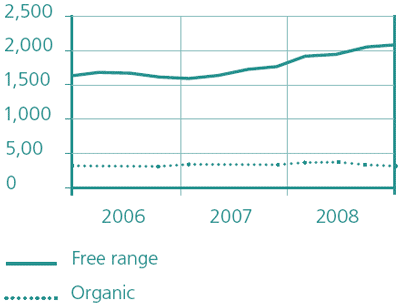



Soil Association Publishes Organic Market Report
The Soil Association has just published its Organic Market Report 2009. The highlights for the poultry industry have been selected by Jackie Linden, editor of ThePoultrySite. Last year, sales of organic food in the UK increased by 1.7 per cent but the market will be tougher in this year of the recession, the report predicts.
General Trends in the Organic Market in the UK
In its recently published Organic Market Report 2009, the Soil Association's Policy Director, Peter Melchett, reports that statistics published in February and March 2009 show no let-up in the financial downturn that has gripped the UK economy since last summer. In the past year, gross domestic product has fallen by 1.9 per cent, unemployment has increased by 1.3 per cent, while retail sales have dropped by 1.8 per cent.
Against this background, Mr Melchett is encouraged that sales of organic food increased by 1.7 per cent last year – in marked contrast to the prophecies of doom made by some. This growth points to some underlying resilience in the organic market, suggesting that it has the potential to grow dynamically once the economy picks up.
Like all consumers, organic shoppers have been tightening their belts by shopping less often, buying fewer premium products and prepared foods, and switching to lower-cost retailers.
The overall growth in organic sales by value masks a net decline in the sales volume of a fair few categories of organic food products during the year, according to Mr Melchett. The picture is mixed, with dynamic growth in sales of organic food through farmers' markets and at Asda, as well as in some new, and still small, areas of organic sales such as textiles and health and beauty products.
However, Mr Melchett highlights that there is a core of consumers who are in no mood to ditch their commitment to organic products. They are far more likely to cut their spending on eating out, leisure activities and holidays than to reduce what they spend on organic food. They would rather economise by buying cheaper cuts of organic meat or by buying frozen organic vegetables than by compromising their organic principles. Thirty-six per cent of these committed organic consumers expect to spend more on organic food in 2009, and only 15 per cent expect to spend less.
Key Statistics
UK sales of organic products increased overall by 1.7 per cent in 2008 to over £2.1 billion, growing strongly in the first six to nine months and then falling back in the face of the economic downturn in late 2008 and early 2009, according to the Soil Association report.
Sales through multiple retailers increased by 1.8 per cent to £1.54 billion; sales through independent retailers are up 1.4 per cent to £568 million.
Ninety per cent of UK households buy organic products. Dairy products account for 29.5 per cent of spending; fresh fruit and vegetables for 26.2 per cent; red meat and poultry for 8.9 per cent and beverages for 8.6 per cent.
Global sales of organic food and drink reached an estimated £23 billion by the end of 2007, which represents an annual increase of seven per cent.
Producers' Perspective
* "The way forward must be to develop a truly sustainable market place, with more co-operation between producers and their customers. " |
Graeme Matravers is a Leicestershire arable, sheep, beef and poultry producer and chair of the Soil Association's Farmer and Grower Board, offered his views in the Soil Association report.
With its whole-system approach to farming, organic production should be better placed to weather the ups and downs of the market. He explained that most producers have an enterprise mix that tends to balance out the peaks and troughs.
In spite of this, 2008 was a very tough year for many organic producers, wrote Mr Matravers. The harvest was one to forget with its dreadful weather, poor quality and low yields. The bumper prices in the first half of the year had a dramatic impact on the cost of feed, causing severe difficulties in the market. Then came the onset of recession, and little did we know what was about to hit us.
Life will certainly be different in 2009, he writes. Demand overall has levelled off, and has fallen in some markets. He believes, however, that those genuine producers with good local links to the market should continue to do well. The interest and concern of their most committed customers is likely to be expressed in continued support.
Mr Matravers sees a way forward by developing a truly sustainable market place, with more co-operation between producers and their customers. It is in no one's interest, he writes, to have inflated prices one year and poor prices the next. One person's short-term profit is more than likely someone else's loss.
Contemplating the year ahead and the effects of the global recession and credit crunch, he reflects on the words of the Soil Association's founder, Lady Eve Balfour. "If fresh food is necessary to health in man and beast," she wrote, "then that food must be provided not only from our own soil but as near as possible to the sources of consumption."
Mr Matravers concludes, "I remain optimistic about the future. With all the uncertainties we face – including peak oil, climate change and economic challenges – it is more vital than ever to build a sustainable farming system that will stand the test of time."
UK Market for Organic Poultry Products
The Soil Association draws upon data from the TNS Worldpanel and other sources to build a picture of UK market for organic poultry products.
Poultry meat
* "Some shoppers are 'trading down' to free-range poultry." |
According to TNS Worldpanel data, poultry accounts for 2.9 per cent of take-home sales of organic products in the UK. The Soil Association estimates that multiple retail sales of organic poultry were worth £44.8 million in 2008. TNS has also reported that the proportion of chicken sales accounted for by organic chicken rose from 0.8 per cent in the year to October 2007 to 0.9 per cent in the year to October 2008.
Organic poultry sales experienced substantial growth up to January 2008. TNS data for that month showed 40 per cent annual growth in sales volume and 56 per cent in market value. This growth trend was maintained until July 2008 – despite limited availability. From July onwards, however, sales slowed down.
Reports at the end of 2008 highlighted significant reductions in organic chicken production at a small and large scale. This may be attributed in part to the high price of organic feed, which prompted many producers to increase prices beyond what consumers or retailers were prepared to pay. Although the welfare of chicken during production is still considered to be the greatest motivator for consumers, some shoppers are 'trading down' to free-range poultry.
Despite a downturn in the organic poultry market in the second half of 2008, Christmas goose sales are reported to have held up well. Demand from the retail and direct markets has been variable, however. It is difficult to predict how the organic goose market will perform in 2009, although a reduction in demand for goslings was reported in January.
The circumstances that the poultry market is likely to face in 2009 present a challenge to producers who cannot reduce production levels on short time-scales. While large-scale outlets continue to promote organic products, such promotions are not sustainable over long time-scales. In March 2009, one leading processor reported a reduction in the number of organic table birds slaughtered to under 45,000 a month from 70,000 in March 2008.
In another section of the report, the Soil Association report notes that leading poultry producer, Lloyd Maunder Ltd, changed its name to 2 Sisters Willand in November 2008 after being bought by the 2 Sisters Food Group earlier in the year. The company has increased overall output but reduced organic production following a drop in retail demand during the summer.
Eggs
| Table 1. Average organic egg prices (pence per dozen; 2006–2008) |
|||
|---|---|---|---|
| 2006 | 2007 | 2008 | |
| Direct | 275 | 285 | 300 |
| Contract | 139 | 148 | 186 |
The quarterly UK egg packing survey records the number and type of all Class A eggs passing over a grader. The survey shows that the number of organic eggs packed on a quarterly basis rose by 14 per cent between 2006 and 2008. On average, 107,640 organic eggs were packed every three months in 2006. This figure increased to 122,760 in 2007, and then declined slightly to 122,400 in 2008.
According to TNS Worldpanel data, eggs account for 3.9 per cent of take-home sales of organic products in the UK. The Soil Association estimates that multiple retail sales of organic eggs were worth £60.2 million in 2008.
The marginal reduction in the number of eggs packed between 2007 and 2008 may be attributed to a decrease in packing numbers in the last six months of 2008. Production of free-range eggs increased by 22 per cent between 2006 and 2008, while the number of barn eggs packed declined by 25 per cent and the number of cage eggs by four per cent.

In the early part of 2008, both free-range and organic eggs experienced strong growth. A double-digit percentage increase in sales was reported in January, while cage egg sales experienced a decline in sales for the first time in two years. This growth trend continued throughout February and March, but by May the organic market was reportedly in decline, partly due to inflation in production costs. Despite an increase in sale prices, producers struggled to match the sale price with the additional cost of feed during the summer months.
By June 2008, there was a division in egg sales. Free-range and value lines continued to grow, while standard cage and organic eggs sales dropped. Through the latter months of 2008 attempts to promote organic eggs helped to sustain sales figures to some extent. However, sales continued to decrease as some consumers who had previously bought organic 'traded down' to buy free-range eggs. Despite a weakened retail market, specialist outlets for sales were reported to be maintaining sales levels at the end of 2008.
In the spring of 2008, the average retail price for a dozen medium organic eggs was £3.62, with eggs through direct sales making £3.15 per dozen and contract eggs making £1.70 per dozen. Despite increasing costs of production, prices did not change markedly into the summer and by the autumn, the average retail price had dropped slightly to £3.58 per dozen with eggs sold though direct sales making £3 per dozen and contract eggs making £1.87 per dozen.
EU Legislation and Regulations
In 2008, the European Commission introduced two sets of detailed rules to help implement the revised EU organic regulation approved in 2007.
Commission Regulation 889/2008 – adopted in September – covers conversion, crop and livestock production, processing, packaging, storage, transport and labelling. It lists permitted fertilisers and soil conditioners, crop protection products, additives, processing aids and non-organic ingredients. Its labelling section includes guidelines for the EU organic label, whose use will be compulsory from 2010 on packaged organic products originating within the EU.
Commission Regulation 1235/2008, adopted in December, covers imports of organic products from countries outside the EU and prescribes a simplification of import authorisation procedures.
Further Reading
| - | You can view the full Soil Association report by clicking here. |
May 2009








